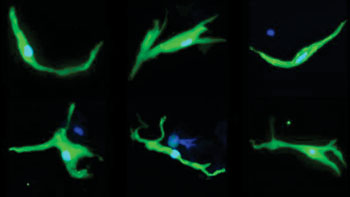Advances in Stem Cell Technology Boost Efforts to Develop a Biological Pacemaker
By LabMedica International staff writers
Posted on 06 Dec 2015
A recent review article summarized the progress being made in the endeavor to develop permanent biological pacemakers to replace the currently used electronic heart pacemakers, which require regular maintenance and periodic replacement.Posted on 06 Dec 2015
The sinoatrial node (SAN), which is located in the right atrium of the heart, is the organ's pacemaker and is responsible for the initiation of the heartbeat. The SAN spontaneously generates an electrical impulse, which after traveling throughout the heart causes the muscle to contract. Although the electrical impulses are generated spontaneously, the rate of the impulses (and therefore the heart rate) is set by the nerves innervating the SAN.

Image: Photomicrograph showing examples of individual pacemaker cells (Photo courtesy of Dr. Vasanth Vedantham, University of California, San Francisco).
Irreversible degeneration of the cardiac conduction system is a common disease that can cause activity intolerance, fainting, and death. While electronic pacemakers provide effective treatment, alternative approaches are needed when long-term indwelling hardware is undesirable. Biological pacemakers comprise electrically active cells that functionally integrate with the heart. Recent findings on cardiac pacemaker cells (PCs) within the SAN, along with developments in stem cell technology, have opened a new era in biological pacing.
A review of the field was published in the November 19, 2015, online edition of the journal Trends in Molecular Medicine. Among other advances discussed in the review were two approaches for development of a biological pacemaker: (1) directing stem cells to become specialized SAN pacemaker cells that could be transplanted into an ailing heart to restore pacemaking function and (2) direct reprogramming of supporting cells already present in the heart to convert them into pacemaker cells.
To continue with both approaches investigators will need to better understand the mechanisms controlling the development and maintenance of pacemaker cells in the SAN, and they must develop methods for comparing experimental biological pacemaker tissue with bona fide SAN tissue. Also, researchers will need to improve the methods used to deliver cells to desired locations within the heart, as well as the recovery of specific individual cells for detailed characterization and functional analyses.
"Theoretically, biological pacemakers, which are composed of electrically active cells that can functionally integrate with the heart, could provide natural heart rhythm regulation without the need for indwelling hardware," said review author Dr. Vasanth Vedantham, assistant professor of medicine at the University of California, San Francisco (USA). "Biological pacemakers must meet a very high standard of performance to supplant electronic pacemakers. Because even a few seconds without a heartbeat can lead to serious consequences, a biological pacemaker would need to exhibit very robust and reliable performance. It remains to be determined whether this will be technically feasible. Despite such challenges, the field is poised for rapid progress over the next few years."
Related Links:
University of California, San Francisco













